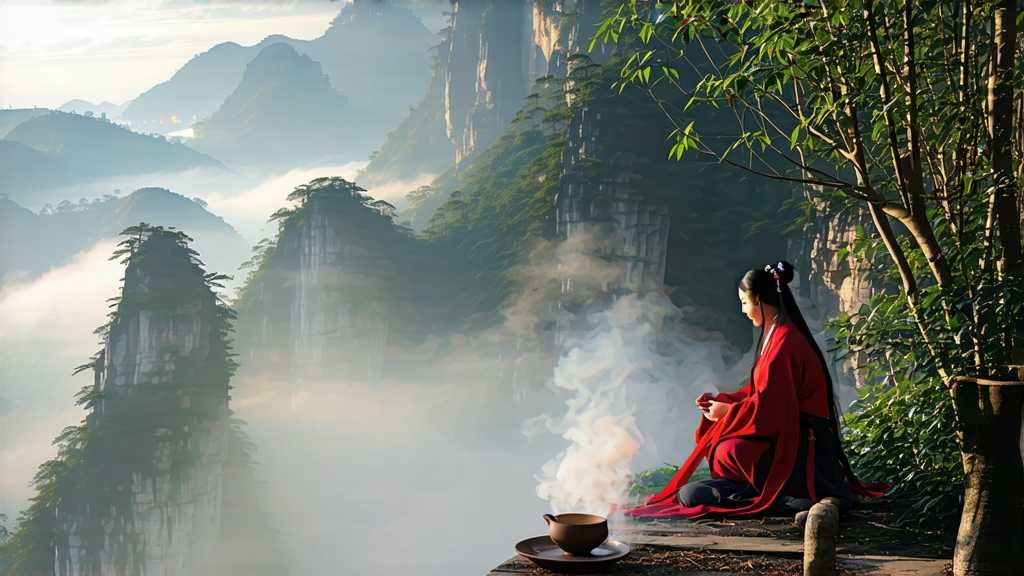
High above the winding Nine-Bend River, the vertical cliffs of Wuyi Shan in northwest Fujian cradle the most mythic of all Chinese oolongs—Da Hong Pao, literally “Big Red Robe.” To international tea lovers the name evokes images of crimson-robed monks, imperial certificates, and mineral-rich infusions that taste of stone fruit, cacao, and the very granite on which the bushes survive. Yet beyond legend lies a living tradition that has refined leaf, fire, and rock into an art form for almost four centuries. This essay invites you to meet Da Hong Pao in its historical, botanical, and sensory dimensions, then to take the tea from story into your own teapot.
-
From Imperial Tribute to Global Icon
The earliest written record dates to 1650, when a Ming-dynasty scholar-official praised “red-robed tea” sent from Wuyi to the capital. Local monks tell an older tale: a Ming emperor’s mother was cured of illness by this tea, whereupon the sovereign sent crimson silk robes to drape the four mother bushes still clinging to Tianxin Rock. Whatever the truth, by the Qing era the court had designated Wuyi rock tea as one of its “north-tribute” items, transported 1,800 km to Beijing along the imperial post road. In 1985, Da Hong Pao cuttings were successfully propagated off the original bushes, turning a once-rare court luxury into a protected geographical indication (GI) crop that now supports 30,000 local families. Today, “true” Da Hong Pao must be produced within the 60 km² Wuyi scenic reserve; leaves grown outside, even from identical cultivars, may only be labeled “Wuyi rock oolong,” testimony to the Chinese conviction that place—what the French would call terroir—is inseparable from taste. -
Cultivars under the Red Robe
Genetic fingerprinting shows that the four ancient mother bushes belong to a single heterozygous population known in botany as the “Qi Dan” strain. Cuttings taken in the 1960s gave rise to three commercial lines now dominating the market:
• Bei Dou #1 – the first generation cloned directly from the mother bush; prized for its cold-resistant vigor and bright orchid fragrance.
• Qi Dan – the pure-strain descendant, lighter in body but with pronounced “rock rhyme.”
• Que She (“Sparrow Tongue”) – a natural mutation selected for tiny, narrow leaves that yield a honeyed cup.
Blended Da Hong Pao (often called “commodity DHP”) combines leaf from these cultivars with other Wuyi varieties such as Rou Gui and Shui Xian to achieve a consistent, affordable profile. A label reading “mother-tree Da Hong Pao” is almost certainly apocryphal; the last harvest from the original bushes occurred in 2006, and the 20 g were auctioned for ¥208,000, entering the China National Museum thereafter.
-
Crafting Rock Essence: The Eight-Step Sequence
Rock oolong is the most labor-intensive tea in China, requiring eight precise stages that stretch across four seasons: -
Picking – only the middle-sized “zhong kai mian” three-leaf and a bud standard is plucked during the brief spring window of late April, when leaf turgor peaks.
-
Solar Withering – leaves are spread on bamboo trays under 9–11 a.m. sunshine to reduce moisture to 65 %; the mountain’s morning mist prevents over-desiccation.
-
Indoor Withering – shaken every 30 min on water-screen racks to bruise leaf edges, initiating oxidation while the veins remain green.
-
Green-Leaf Shaking – the signature “yao qing” step: 120–180 tosses in a rattan drum create microscopic cracks that allow partial oxidation (30–40 %), the midpoint between green and black tea.
-
Sha Qing – pan-firing at 240 °C for 7 min kills enzymes and fixes the hybrid character.
-
Rolling & Twisting – cloth-wrapped leaves are kneaded into the traditional “dragonfly head, frog leg” strip shape, forcing juices to the surface for later caramelization.
-
Charcoal Roasting – the soul of Wuyi craft. Leaves are baked over a subdued ember of local hardwood ash for 6–10 h, rested 20 days